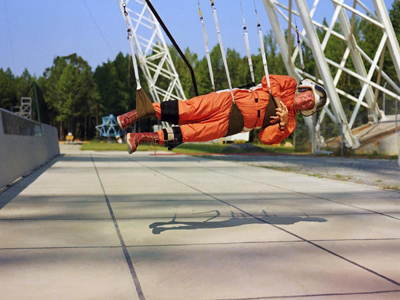Onward to Cabeus A!
Friday, September 11th, 2009
I just got finished with watching, on NASA TV, a press conference at Ames Research Center to announce the target crater of the LCROSS mission. Before the selection was revealed, though, project manager Daniel Andrews announced some unexpected news. NASA has now dedicated the LCROSS mission to the memory of Walter Cronkite, the famous news anchor for CBS television who was for so many people the voice of the space program in the 1960s and early 1970s. A wonderful gesture!

Walter Cronkite tries out a lunar gravity simulator, in 1968 (NASA photo)
“Dad would be very pleased to be part of this process,” said Chip Cronkite, Walter Cronkite’s son, who was at the news conference. He also expressed the hope that, if water is indeed found at the lunar south pole, “once you build a fuel station there, we’ll have another renaming.”
After that announcement, Tony Colaprete announced the target crater: Cabeus A, a 40-kilometer wide crater that is at approximately 81 degrees south latitude. He outlined the four main criteria on which the selection was based and why Cabeus A satisfied those criteris:
- Flat topography that does not block the visibility of the ejecta
- “Fluffy” terrain that is smooth and boulder-free, with slopes of less than 5 degrees
- Existing evidence of water ice in the crater
- Visibility from Earth
Cabeus A was especially attractive in terms of the last two criteria. The best evidence for water comes from the neutron spectrometer that flew on the Lunar Prospector mission (late 1990s) and the more accurate neutron spectrometer that is flying on the LRO mission right now. These instruments detect neutrons coming from the moon’s surface, and a dip in neutrons of a certain energy (“epithermal neutrons”) indicates the presence of hydrogen. Note that this method only detects hydrogen — it does not discriminate between water and other hydrogen-containing molecules! Conceivably we could be seeing methane or hydrocarbons. We won’t know until the LCROSS mission tells us. But in any case, Cabeus A has one of the best “sweet spots,” as Colaprete called it, where the concentration of water ice (assuming that is what it is) exceeds 2 percent.
Also, Colaprete pointed out that Cabeus A offers excellent viewing. Because it is a little farther from the south pole than some of the other candidates, it is easier for Earth-based telescopes to see, and as proof he showed a photograph taken from the Apache Point observatory (one of the six large Earth-based observatories that will watch the impact), in which the crater shows up very clearly.
Colaprete said that the impactor will be targeted to within 3 kilometers and probably quite a bit more accurately than that. One of the reporters asked when the results from the impact would be known. Colaprete said they will know almost immediately whether the experiment has been a success, in terms of the size of the debris plume and whether it has been seen successfully by the LCROSS spacecraft and ground telescopes. They will probably want to take a little time to determine whether they have seen water ice, and of course, it will depend on how much they see. He said they are required to report the results within 3 months of the impact, and he mentioned 30 days as a more likely time frame.
One other interesting question concerned LCROSS’s fuel usage. At one point last month, when the spacecraft was out of the controllers’ view, there was what Andrews called an “anomaly in an avionics element.” Basically, the spacecraft was burning a lot of fuel when it wasn’t supposed to. When they realized what was happening, they were able to shut down the burn. But the result was that, instead of having a lot of extra fuel, the spacecraft now has just enough. “Fuel efficiency is now incredibly important,” said Andrews.
Andrews explained that the fuel tank in LCROSS isn’t like the gas tank in your car, which has a float in it that tells you how much fuel you have left. If you think about it, a float would not work very well in zero gravity! So there is a little uncertainty over how much fuel is left, but even in the worst-case scenario they are confident that they have enough to complete the mission successfully.
You might think that an unscheduled fuel burn might have taken the spacecraft off course or made it start tumbling, but none of that happened. In fact, LCROSS is so perfectly on course that they have canceled three trajectory correction maneuvers, including one that was scheduled after the “anomaly” happened.
Stay tuned, and get ready to point your telescopes at the Moon’s south pole at 4:30 am (Pacific time) on October 9!
P.S. Although it’s unlikely, I would be very interested to see what would happen if we found methane or hydrocarbons at the lunar South Pole instead of water! That might generate quite a bit more interest (and money) for going back to the moon. I’m not sure whether it would be a good thing, though – once the oil companies got involved, it would be very hard to preserve the moon as a resource “for all mankind.”
How could there be methane at the lunar South Pole? Well, it kind of depends on how ubiquitous it was in the early solar system. The permanently shadowed craters are good traps for any kind of volatile (i.e., easily vaporized) molecules, not just water. We’ve seen that there is lots and lots of methane on Saturn’s moon Titan — why not our own?
Another interesting point that Colaprete brought out is the fact that we have no idea how much hydrogen/water/whatever is present below the surface. The neutron spectrometers only see hydrogen that is less than a meter from the surface. So we could in fact have huge concentrations of water ice farther down, and we wouldn’t know it. Hence, once again, the incredible importance of an impact mission, which will excavate material from a depth of several meters.
